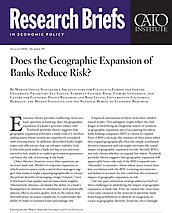Our two-part estimation strategy addresses both of these challenges to identifying the impact of geographic expansion on bank risk. First, we exploit the cross‐state, cross‐time variation in the removal of interstate bank branching prohibitions to identify an exogenous increase in geographic diversity. From the 1970s through the 1990s, individual American states removed restrictions on the entry of out‐of‐state banks. Not only did states start deregulating in different years, some also signed bilateral and multilateral reciprocal interstate banking agreements in a somewhat chaotic manner over time. This enormous cross‐state variation in the 20‐year process of interstate bank deregulation culminated in the Riegle‐Neal Interstate Banking Act of 1995, which eliminated all remaining restrictions on interstate banking and branching.
The second building block involves embedding this dynamic process of deregulation into a model of individual BHC investments in metropolitan statistical areas (MSAs) other than the one where the BHC is headquartered. This model yields projected shares of deposits that each BHC would have in other MSAs, with and without interstate bank regulatory prohibitions on owning a subsidiary in that MSA. We then use this BHC-specific projection of diversity to examine whether a BHC’s geographic expansion reduces its risk.
We find that geographic expansion materially reduces BHC risk. This finding holds after controlling for a wide array of time‐varying BHC characteristics, such as size, growth, profitability, stock market valuation, operating income, the degree of non-lending activities, and the capital‐to-asset ratio. Across an array of specifications and robustness tests, we find an economically large effect.
We also examine a BHC’s expansion into economically similar and dissimilar MSAs. If geographic diversity lowers risk only by facilitating the diversification of idiosyncratic local risks, then the risk-reducing impact of expanding into dissimilar MSAs should be large and significant while the risk-reducing impact of expanding into economically similar MSAs should not. We find that this is the case: geographic expansion only reduces risk when BHCs expand into economically dissimilar MSAs, that is, MSAs with asynchronous business cycles. Geographic expansion into economically similar MSAs, on the other hand, does not reduce BHC risk.
We also assess an additional channel through which geographic expansion might influence BHC fragility: changes in loan quality. As noted above, some research suggests that geographic expansion might reduce the quality of bank loans and the monitoring of those loans. We find, however, that an increase in geographic diversity does not have an impact on loan loss provisions, nonperforming loans, or loan charge-offs. Thus, we cannot reject the hypothesis that geographic expansion has no effect on loan quality.
It is important to emphasize the boundaries of our analyses. We do not assess each of the potential mechanisms linking geographic expansion and risk. Rather, we assess the net impact of geographic diversity on BHC risk more precisely than past studies, evaluate the hypothesized gains from diversifying into different local economies, and gauge whether the effects of geography on risk are driven by changes in loan quality. The findings indicate that geographic expansion materially reduces BHC risk when banks expand into economically dissimilar local economies.
Our findings also contribute to long-standing policy deliberations. The risk-taking behavior of banks potentially affects financial and economic fragility. In turn, national regulatory agencies have adopted, or are considering adopting, an array of regulations, including geographic concentration limits, to shape bank risk. For instance, in the United States, no BHC is permitted to gain more than a 10 percent share in the market for deposits. And the Basel Committee for Banking Supervision, in its effort to contain the financial system’s systemic risk, has proposed capital surcharges for systemically important banks and considers a bank’s global footprint to be an important indicator of its systemic importance. Yet the literature has not offered conclusive evidence on the impact of restrictions on geographic diversity on bank risk.
NOTE:
1. This research brief is based on Martin Goetz, Luc Laeven, and Ross Levine, “Does the Geographic Expansion of Banks Reduce Risk?” Journal of Financial Economics 120, no. 2 (June 2016): 34–62.

